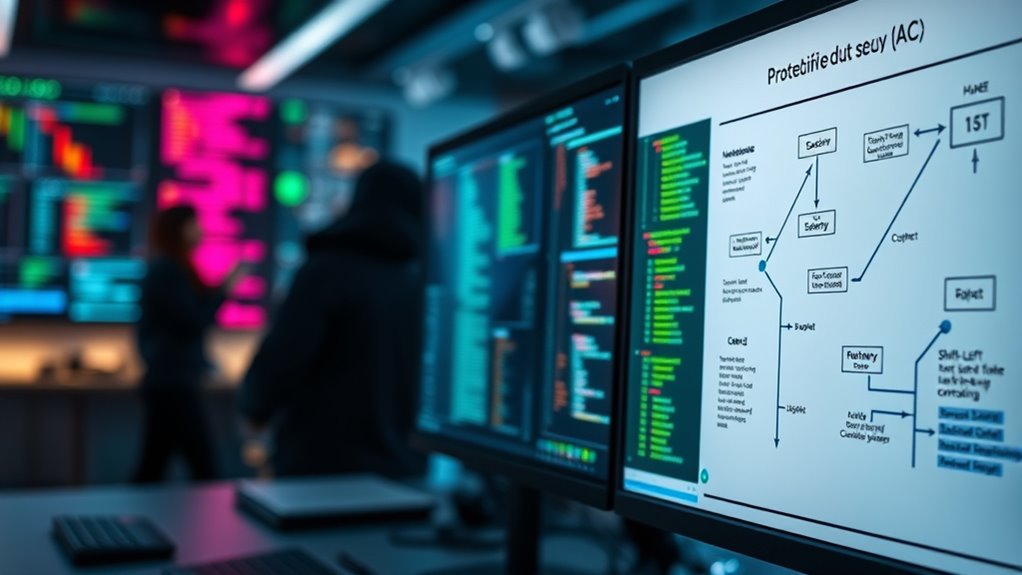To secure your Infrastructure as Code before it hits production, you should adopt shift-left security practices. Embed security measures early by automating compliance checks, continuously evaluating IaC against policies, and providing instant feedback to developers. Invest in developer training to foster a security-first mindset, and combine automated tools with ongoing education to create a seamless security ecosystem. This proactive approach helps you catch vulnerabilities early, reducing risks and ensuring compliance—discover more ways to strengthen your cloud security now.
Key Takeaways
- Integrate automated compliance tools into the development process to identify vulnerabilities early in IaC scripts.
- Provide developer training on secure coding practices to prevent misconfigurations before deployment.
- Embed security checks within CI/CD pipelines to ensure continuous validation of infrastructure code.
- Foster a security-first culture by promoting collaboration between security teams and developers during development.
- Reducing security risks and compliance issues by addressing vulnerabilities proactively before IaC reaches production.

As organizations increasingly adopt cloud technology, integrating security early in the development process becomes essential. This approach, known as shift-left security, focuses on embedding security measures during the development of Infrastructure as Code (IaC), before it reaches production. By shifting security left, you can catch vulnerabilities early, reduce costly fixes later, and ensure your cloud environment remains compliant with industry standards. One of the key components of this strategy is automated compliance. Automated compliance tools continuously evaluate IaC scripts against security policies and regulatory requirements, providing immediate feedback to developers. This not only accelerates the development cycle but also ensures that security and compliance are integral parts of the process, rather than afterthoughts. Automated compliance reduces manual effort, minimizes human error, and offers scalable, real-time validation, making it easier to maintain consistent security standards across multiple projects and teams. Additionally, integrating risk assessment into the development process helps prioritize vulnerabilities and allocate resources effectively.
Alongside automated compliance, developer training plays a crucial role in shift-left cloud security. When developers are educated about security best practices and the specific vulnerabilities associated with cloud environments, they become proactive in writing secure code from the start. Training sessions can cover topics such as secure coding principles, common cloud misconfigurations, and how to leverage security tools effectively. By empowering your developers with knowledge, you foster a security-first mindset that influences their everyday work. Well-trained developers are more likely to identify potential issues early on, write resilient IaC, and understand the importance of compliance checks embedded within their workflows. This reduces the need for extensive security reviews later in the pipeline and speeds up deployment cycles.
Integrating automated compliance and developer training into your shift-left strategy creates a seamless security ecosystem. Automated tools can provide instant feedback during the coding process, while ongoing training ensures your team understands why these measures matter and how to implement them effectively. This combination helps establish a culture of security, where developers see security as an integral part of their responsibilities rather than an obstacle. It also encourages collaboration between security and development teams, breaking down silos and promoting shared accountability. As a result, your organization benefits from faster releases, fewer security incidents, and a more resilient cloud infrastructure. Ultimately, shifting security left isn’t just about tools; it’s about cultivating a mindset that prioritizes security at every stage of development. This proactive approach is crucial to stay ahead of evolving threats and maintain compliance in the fast-paced cloud landscape.
Frequently Asked Questions
How Do I Measure the Effectiveness of Shift-Left Security?
To measure the effectiveness of shift-left security, you should track automated compliance rates, which show how well security checks are integrated early. Monitor developer education efforts to guarantee teams understand secure coding practices. Observe the reduction in vulnerabilities found during later stages, and gather feedback from developers about security tools. These indicators help you see if proactive security measures are improving code quality and preventing issues before deployment.
What Tools Integrate Best With Iac Security Practices?
You should look for tools that seamlessly integrate automated testing and compliance frameworks into your IaC workflow. Tools like Terraform Cloud, Checkov, and Terraform Sentinel are great options because they automatically scan your code for security issues and guarantee compliance before deployment. By using these, you can catch vulnerabilities early, maintain standards, and streamline your security practices, making your IaC more resilient and aligned with best practices.
How Can Teams Overcome Resistance to Shift-Left Security Adoption?
To overcome resistance to shift-left security adoption, you need to foster a team culture that values security early in development. Engage stakeholders by demonstrating how integrating security practices saves time and reduces risks. Encourage open communication, provide training, and showcase quick wins. When everyone understands the benefits and feels involved, resistance diminishes, making it easier to embed security into your development process from the start.
What Are Common Pitfalls When Implementing Shift-Left Cloud Security?
Did you know 75% of breaches originate from insecure code? When implementing shift-left cloud security, common pitfalls include neglecting to foster a strong security culture and inadequate developer training. If you overlook these, security becomes an afterthought rather than a priority. To avoid this, you need to embed security practices early and equip your team with the right skills, ensuring security is integrated seamlessly into your development process.
How Does Shift-Left Security Impact Overall Development Timelines?
You might worry that shift-left security could cause development delays, but it actually streamlines the process. By catching issues early, your team collaborates more effectively, reducing rework later. This proactive approach helps identify vulnerabilities sooner, minimizing disruptions during later stages. Overall, it speeds up development timelines, keeps projects on track, and fosters a culture of security awareness among your team members.
Conclusion
Now that you understand the importance of shifting security left in your cloud journey, one question remains: are you truly prepared to catch vulnerabilities before they reach production? Every step you take today shapes your future resilience, but the real challenge lies ahead—anticipating threats before they materialize. The path to secure infrastructure isn’t just about tools; it’s about mindset. Are you ready to stay one step ahead and safeguard your cloud environment from the unseen dangers lurking in your IaC?




